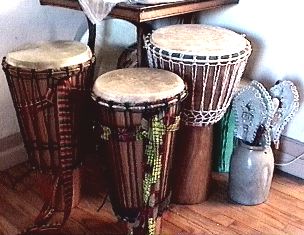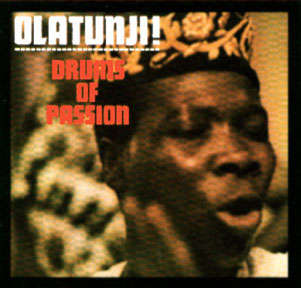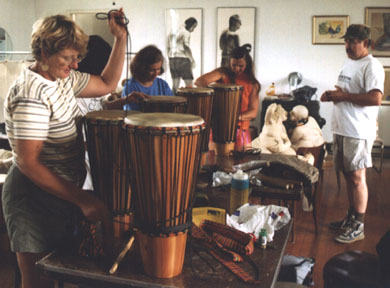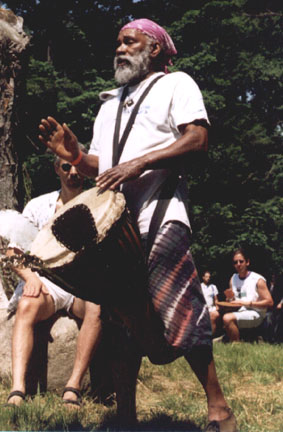
Drumming Roots
by Juan Wilson
(C) 1999 The Gobbler
- There was a time about forty years ago that
drumming became important to me. It began when I was in my early
teens and we lived in a new Levitt house on Long Island. Other
than what was in the local stores (a recently built supermarket,
pharmacy and newsstand) there wasn't anything to buy in
Levittown... certainly nothing exotic or intriguing. My mother was
so desparate she joined The Gift Of The Month Club. The Club was a
scheme to mass merchandise bizarre items from exotic places to
middle class Americans. Once signed up, every month we received a
new Club item: An ivory letter opener from India, a blue and white
Dutch tile from Holland; a brass figurine from Thailand. At least
it was something unknown and surprising from far away.
-
- Once, just before Christmas, we received a big
foreign crate. This was too big for the Gift Of The Month Club. As
it turned out it was from Betty Douglas. Betty was a lifetime
friend of my mother. She was smart and just as World War II was
starting she had gone to MIT to study architecture, astronomy and
physics. After she graduated from school she worked in Buffalo as
an aerodynamicist for an airplane factory. After the War she
married Keith Knudsen who took her to Rhodesia, Africa (now
Zimbabwe). There they practiced architecture by day and listened
to lions by night. That was where the crate was from, Rhodesia. It
was a gift for me and my sister.
- We opened the crate on Christmas morning.
Inside were several packages. Two contained thumb pianos. Betty's
note explained that they were called "ochisangi". They consisted
of small decorated boards with several metal prongs of differing
length supported securely by a wooden bridge. The board was held
with two hands. It was played by snapping your thumbs on the
prongs to make made different musical notes.
-
- There was still one big item in buried in the
wooden shavings packed in the crate... a drum. The barrel of the
drum was a single piece of blackened wood that had been hollowed
by hand. The entire surface of the drum had been engraved with an
intricate pattern of carved parallel lines, like Samoan war
tattoos. The drum heads at either end were a gray green snakeskin:
off a big snake. The snake skin was held to the drum with carved
wooden pegs driven into holes in the barrel. This was definitely
not an item you could buy in Levittown. My sister and I were
delighted with this thing, but knew little about playing it
properly. I was most impressed with the snakeskin. It impressed
every guy I knew in the neighborhood as well. We'd bang on the
thing for a while and then go on to something else.
-
- After a few months we left the drum alone.
Some of the pegs had been driven into the drum and rattled around
when the skin was played. By summer the drum was hung up and
forgotten. Every year, my family spent the summer in Panama, New
York at my mother's parents farm. When we returned to Levittown in
August we found that the drum had gone through some changes. It
hung on a wall in our living room and under it was a small pile of
sawdust. Something was living inside the drum. In a moment of
inspiration, my mother mailed the drum to Cornell University for
an analysis. The source of the sawdust was created by a rare
African termite that Cornell's entomologists were delighted to get
their hands on. They returned the drum with instructions for
getting rid of the termites. They involved getting a galvanized
garbage can with a lid and some chemicals. With the right dose the
drum would we unoccupied in about three months. My mother got the
garbage can and set it up in the carport. By the next Christmas we
had the drum back in the house hanging on the wall.

Album cover to "Olatunji! Drums of
Passion"
- Sometime shortly thereafter we heard what that
drum was used for. We got a record called Drums of Passion by
Babatunde Olatunji, a drummer from Nigeria. It was the first high
fidelity long playing record widely distributed of native African
music and caused a sensation. A WINS disk jockey in New York named
Murray the K (Maurice Kaufman) was playing tracks of Olatunji
sandwiched between top twenty hits like the Eternals "Babalu's
Wedding Day" and the Cadets "Stranded in the Jungle". Murray
claimed that Drums of Passion was submarine race watching music.
This referred to kids parked in cars along the Long Island beaches
"making out" as they pretended to watch subs racing offshore. He
popularized the album and some African words like "Akiwowo" (chant
to the trainman) and "Baba Jinde" (flirtation dance). In the
following few years I spent many nights riding shotgun in friend
Kip Bedell's 1960 Chevy banging out rhythm on the vinyl dashboard
while we cruised for gas, burgers and girls.

Ashiko drum making workshop
- Thirty five years later my wife, Linda, bought
me a wonderful birthday present after I turned fifty. She enrolled
me in a two day Ashiko drum making workshop held at the White
Chapel in Mayville, New York that was conducted by Alex Wedmedyk
of Earth Rhythm. The process was easier than it might be because
Alex brings all the materials including the pre finished drum
barrels. Most of the work consisted of preparing and then soaking
the goat hide for the drumhead overnight and then the next day
stringing the drum. Alex's technique of stringing the drum
requires that you lay on your back with the drum between your legs
in what might easily be confused with the birthing
process.

Alex Wedmedyk tightening a
drumhead
- My interest in drumming was rekindled. The
Ashiko I strung has a 10" head and stands a little under two feet
high. It has a sweet deep tone for its size and is light enough to
carry around and play all night. An especially inspiring workshop
was conducted in 1996 at the Blue Heron Music Festival, in Sherman
NY by Emile Latimer, of the group Xalat.

Emile Latimer in a drumming workshop at the Blue
Heron Festival
- Emile is from Buffalo and he demonstrated West
African drumming techniques. That summer, my wife and I found many
occasions and fire circles where people were interested in
drumming. Late in the year I heard that Emile Latimer had arranged
for a special performance at Neitche's on Allen Street in Buffalo.
Emile was bringing Olatunji to Buffalo. I was not even aware that
Olatunji was still alive, much less still performing in America.
This was a show I had to see.
-
- Nietzsche's is a narrow but deep barroom and
music hall. The entire surface of the place, walls and ceiling, is
painted black. There is a stage at the back and a little balcony
on either side of the stage. Nietzsche's often has local,
alternative and interesting music. It's in a section of town that
might be described as "The Greenwich Village" of
Buffalo.
-
- Even though I didn't get along with my teenage
stepson Kevin, I thought it would be a good idea for the two of us
to share the experience of seeing Olatunji together. Kevin was
about the age I had been when I first heard Drums of Passion, and
he was interested in drumming. A call to Nietzsche's confirmed
that they would allow Kevin to see the show if he was accompanied
by a parent or guardian. Buffalo is about and hour and a half
away, and 45 minutes into the trip we stopped for gas. As we were
about to leave the station I was shifting gears on my 1984 VW Bus
and the floor mounted gearshift broke off at the floor. I stopped
the bus and turned off the ignition. Because it was dark Kevin was
unaware of what just happened. As I told him I waved the gear
shift still in my hand. I could see in his eyes that look
indicating that this was going to be another thing for us that
wasn't going to work out.
-
- It seemed that there was nothing to do but
abandon the bus and the idea of seeing Olatunji. However, Kevin's
disappointed look got me to work. The gear shift shaft was a
hollow tube, and was probably was why damn thing broke off in my
hand. I found a large screwdriver and a Vise grip wrench in the
back of the bus. I jammed the screwdriver blade into the hole in
the tube sticking out of the floor and opened the grip on the
wrench. I clamped the Vise grip at the end of the screwdriver
handle so I could reach it from a sitting position. But it was too
difficult to drive and shift. We found that I could drive if Kevin
shifted with two hands on our jerry rigged gear shaft. To our
surprise we got to Buffalo on time and found parking a couple of
steps from Nietzsche's door. That night turned out great. Olatunji
shared the stage with Emile's group Xalat. Somehow a troop of
dancing women, dressed in African dress, jammed onto that little
stage with Xalat and Olatunji. As Kevin said at the time "That was
awesome!" At Christmas time Linda and I went to Buffalo Drums to
buy Kevin a drum.
-
- These days Linda and I take our Ashiko's to
drumming circles whenever someone invites us. We also attend
drumming sessions at "The Center for Spirituality" in nearby
Jamestown. Alex occasionally holds a drum making workshop there,
too. For me the drum has become a spiritual connection with other
people and nature.
-
- SOURCES
- "Olatunji! Drums of Passion"
- by Olatunji is still available from Columbia Records
-
- "Earth Rhythm"
- drums, drum making workshops and drum lessons
- Alex Wedmedyk 3661 Magnolia OH 44212 (330) 273-6260
-
- "Xalat"
- West African Drumming
- Emile Latimer, Buffalo NY (716) 885-0224
-
- "The Center for Spirituality"
- 514 Second Street, Jamestown NY, 14701 (716) 483-6877
- Maggie Monroe-Castle, director
- drum workshops Friday nights 7-9
-
- Nietzsche's
- Bar and showplace for alternative, local and interesting
music
- Allen Street, Buffalo NY (716) 886-9539
-
- "Buffalo Drum"
- Waldemeer Avenue, Cheektowaga NY (716) 897-0950
-
Home





